The best way to bring down the installed cost of a solar system is to reduce both the balance of system and labor. A new module attacks both areas with an adhesive, non-penetrating, non-racking system that can be quickly installed by just one person.
Publicity around Lumeta’s adhesive, light-weight crystalline silicon solar panel has come in spurts over the last eight years, so you’ll be forgiven if you haven’t heard of the game-changing product. Seen exhibiting at Solar Power International in 2010, Lumeta went back to the drawing board and used its involvement in a SunShot Initiative-funded program to now launch both residential and commercial products in 2017.
We’re sure solar installers have many questions about Lumeta’s LPP modules—Adhesive? No penetrations? No racking? What?
We chatted with Lumeta CEO Timothy Davey to learn more.
What’s Lumeta’s history?
Davey and the rest of Lumeta’s founders have nearly 30 years’ experience in the commercial roofing business, installing roofing systems through DRI Companies. In 2007, DRI customers approached the team for suggestions on solar systems appropriate for commercial rooftops.
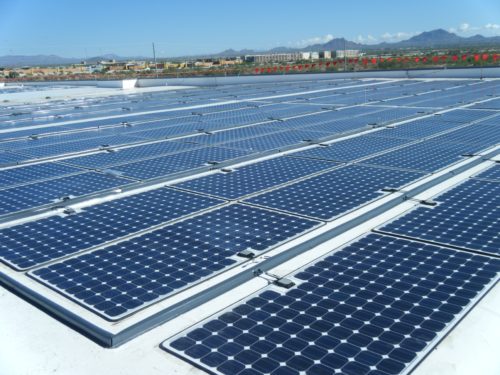
Lumeta’s first peel-and-stick commercial product, shown here installed on the roof of the Musical Instrument Museum in Phoenix
“Our customers, especially the big box retailers, began asking us to help them identify solar systems that didn’t have an adverse impact on the additional load increases caused by traditional rack-mounted systems, as well as the numerous penetrations required to install rack-mounted solar systems,” Davey said.
Rather than give business to other suppliers, DRI invented the non-penetrating, peel-and-stick Lumeta module.
January 2011 saw the first commercial installation of Lumeta’s PowerPly solar panels on the roof of the Musical Instrument Museum in Phoenix. The museum’s president touted Lumeta’s “no-compromise” efforts to the roof’s integrity. The panels, first marketed as a BIPV option, had a 400-W peak power rating and 13.8% efficiency. Using DuPont Tefzel front sheets instead of glass, Lumeta panels also eliminated the need for aluminum frames. Back then, they weren’t super light-weight (65 lbs on its 2010 spec sheets), but the lack of 2010 racking supplies definitely contributed to an overall lighter system.
What’s the story behind the new generation modules?
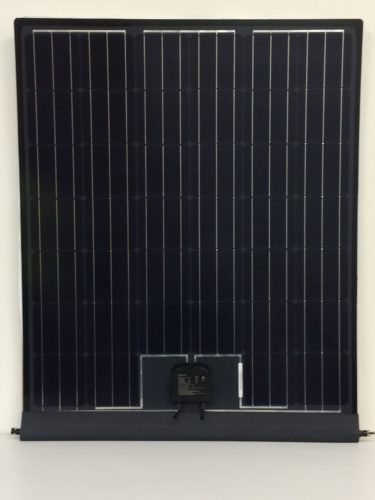
The Lumeta LPP-175S module for asphalt shingle roofs
The second generation Lumeta modules (LPP-175S and LPP-185T) will launch in Q1 2017. They’ve changed a lot from their initial design—and they’re backed by some solid research.
LPP-175S, intended for application over asphalt shingle roofs, was developed in conjunction with the Fraunhofer Center for Sustainable Energy Systems (CSE) through the Plug and Play PV for American Homes program. The program’s objective is to complete a plug-and-play PV system that can be installed in 10 or fewer man-hours by someone without prior solar experience and meets the SunShot goal of $1.50/watt installed cost for the residential market by 2020. The complementary LPP-185T module is suited for concrete tile roofs.
Fraunhofer CSE successfully completed its first full-scale installation of its Plug and Play PV system (with Lumeta modules) in November 2014, and Lumeta received UL 1703 certification on both LPP module lines in late 2015.
What’s the technical data?
The two module lines are basically identical except in a few small areas, but from here forward we’ll discuss the shingle module (LPP-175S).
The Lumeta panel weight has dropped to around 17.5 lbs, and it’s only 3 mm thick (a traditional glassed panel is about 35 mm thick). Forty monocrystalline silicon cells encompass the square-like module shape.
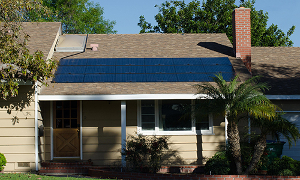 Davey said the company went with silicon instead of a more BIPV-friendly thin-film material to “take advantage of c-Si’s proven long term output performance as well as its high conversion efficiency.”
Davey said the company went with silicon instead of a more BIPV-friendly thin-film material to “take advantage of c-Si’s proven long term output performance as well as its high conversion efficiency.”
Lumeta modules (175 W for the shingle module, 185 W for the tile module) adhere to the roof with a thermoplastic butyl adhesive that has been wind tested to 120 mph. This time-proven adhesive (branded Royal/ADCO) can be removed by heating the module with a commercial utility blanket (to ~175° F), with no damage to the roof. If the module would then need to be reinstalled, adhesive would have to be reapplied. Instead of glass, the topside of the module is again sealed with a DuPont Tefzel front sheet with a tapered edge to prevent soiling and water ponding.
The junction box is housed on top of the panel (it’s on the backside for the tile roof panel), and a tray is pre-installed on the top edge to cover and manage wires (underneath on a tile roof). With no penetrations or need for row spacing, the Lumeta modules can connect together for a seamless, monolithic array. To ensure ideal adhesion on tile roofs, shaped inserts/wedges are adhesively applied to the roof to create a flat surface for the full module to attach.
Davey said microinverters can be used with the Lumeta modules, which will prove to be easier if/when microinverter sizes get smaller. The company is considering offering modules with DC optimizers to accomplish module-level shutdown, installed in place of the junction box.
What’s the catch?
It’s difficult to compare the Lumeta module to either BIPV products or traditional, rigid crystalline. They sort of fall into a brand new category.
“[Lumeta is] comparable if not superior in its electrical production (to glass c-Si panels) but much lighter, non-penetrating and more aesthetically pleasing,” Davey said. “More importantly is our ability to provide a module with a price point that will result in the lowest installed system cost on the market for rooftop installations, given the offset of BOS and labor costs.”
Installers are able to complete five times the number of residential installations in the same timeframe and with the same work force as a standard rack-mounted system on an asphalt shingle roof, Lumeta claims. Tile roofs can see a 15-times installation improvement.
The residential modules are a modest 175-185 W, with a commercial model expected to hit 320 W. Davey said the company is going through testing right now and expects next generation modules to have a higher wattage—predicting 270-280 W for the shingle and tile panels. As output gets more competitive, the modules can make more sense in all situations.
Installation is faster and less labor intensive than traditional racked systems, that’s obvious. A Lumeta system is ideal for consumers concerned about aesthetics, roof penetrations and/or roof load. If someone is looking for maximum output, Lumeta isn’t 100% there yet, but the cost savings are difficult to ignore.

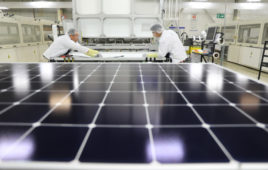

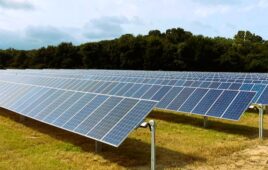
PV, as the roof surface, will have its place when incorporated in the full roof structure, not just as a laminate on whatever the existing roof may be. Such an approach should address all of the concerns of comments thus far, but what this custom PV roof structure is has yet to be determined.
In response to Joe Morinville, Joe Byles and Stuart’s comments and questions, following are my responses:
If they release at 175 degrees, then how will they stay on a roof shingle that can easily get over 200 degrees in the summertime? Won’t the adhesive release?
The adhesive is designed to soften at 175°F to the point that it can be pulled slowly and carefully with a strong steady force to cause cohesive yielding of the adhesive without damaging either the shingle roof or the solar module. High winds will cause the module to cool well below these temperatures so it will always stay secure under any foreseeable weather conditions.
Exposed shingle temperatures can get quite hot, perhaps even 200F (93.3C). But the shingles underneath the adhered modules experience lower temperatures. Outdoor experiments, conducted by Fraunhofer, CSE in Albuquerque, NM, show that the shingles underneath the modules are found to be 10C cooler at the highest temperature. For example, maximum temperatures of the exposed shingles reached 85C (185F), but the shingles under the modules reached only 75C (167F). Fraunhofer has an article on the effect of adhesive mounting on the rooftop temperature and thermal loads is in progress.
How are they grounded?
There are no exposed metal parts on the Lumeta frameless module. Therefore, the Lumeta module does not require grounding.
Do you have any issues with shingle warranties from shingle manufacturers?
A major US shingle manufacturer, CertainTeed, has provided Lumeta a warranty waiver, which reads, “The installation of Lumeta’s solar module LPP-175S over CertainTeed shingles will not void the limited asphalt shingle warranty”.
How does the lack of air flow under the panel affect the system output? Do you have any real world numbers yet?
Fraunhofer, CSE did a side by side temperature comparison with Lumeta modules and rack mounted modules on a shingle roof in Albuquerque, NM. They found that there is an average of 5oC temperature difference between the two systems. This results in a system output difference of about 3%.
Sounds promising but I can’t help but be doubtful of the ability of any adhesive to perform reliably after 25 years of freeze thaw cycles.
The adhesive has been in commercial use for over 20 years and has been tested for its ability to meet the demands of attaching solar modules. It has been tested under conditions beyond those required for module certification per UL and IEC. This includes damp heat, thermal cycling, humidity freeze, UV exposure, and relative thermal index testing. In addition, it has been tested under water immersion and freeze/thaw conditions. The adhesive is designed to soften at 175°F to the point that it can be pulled slowly and carefully with a strong steady force to cause cohesive yielding of the adhesive without damaging either the shingle roof or the module. High winds will cause the module to cool well below these temperatures so it will always stay secure under any foreseeable weather conditions.
I also wonder about how the Tefzel will perform after years of ultraviolet bombardment, hail, snow and bird droppings which can be acidic.
Tefzel film has been extensively tested by DuPont for over 30 years.
Tefzel film has outstanding resistance to strong mineral acids, inorganic bases, halogens and metal salt solutions. Tefzel film is rated for continuous exposure at 150°C (302°F), based on the 20000-hour test result (http://www2.dupont.com/Products/en_RU/Tefzel_ETFE_fluoropolymer_resin_en.html). DuPont has performed long term UV testing equivalent to 25 years’ exposure on Tefzel film which resulted in no noticeable degradation in the film’s light transmittance.
Yes, I’ve seen asphalt shingle roofs at 200 deg F plus. If they release at 175 deg F, they won’t meet uplift of 2703 at operating conditions. Also, Si temp degradation with no underneath cooling will kill production and shorten life
Section 21 of UL2703 requires that the module attachment withstand 45 psf uplift for 30 min. Using the ASCE 7-10 equations with reasonable assumptions, this uplift pressure corresponds to 150 mph wind gust velocity. It is unlikely that the roof temperature can be maintained at 200F during hurricane-force winds.
The front face radiative cooling and the slight gap between the module and the roof dissipates heat so that the roof under the module is 10°F to 20°F cooler than a shingle directly exposed to the sun.
The Lumeta module’s temperature is only slightly higher than rack mounted module’s temperature. Because Lumeta modules dissipate heat mainly through the Tefzel front sheet as opposed to a glass front sheet. This results in cooling via convection and radiation. Natural convection due to the gaps beneath the modules and the roof surface further enhances the modules’ overall heat dissipation.
Sounds promising but I can’t help but be doubtful of the ability of any adhesive to perform reliably after 25 years of freeze thaw cycles.
I also wonder about how the Tefzel will perform after years of ultraviolet bombardment, hail, snow and bird droppings which can be acidic.
Yes, I’ve seen asphalt shingle roofs at 200 deg F plus. If they release at 175 deg F, they won’t meet uplift of 2703 at operating conditions. Also, Si temp degradation with no underneath cooling will kill production and shorten life
Interesting product.
If they release at 175 degrees, then how will they stay on a roof shingle that can easily get over 200 degrees in the summertime? Won’t the adhesive release?
How are they grounded?
Do you have any issues with shingle warranties from shingle manufacturers?
How does the lack of air flow under the panel affect the system output? Do you have any real world numbers yet?